BR Standard class 5MT 4-6-0 number 73067 climbs Shap bank near
Scout Green with a down freight banked by a Standard class 4 4-6-0 during the last month
of steam working over this section
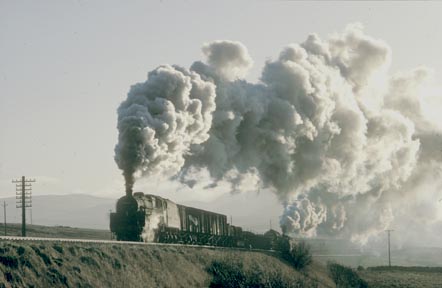
Railway Rantings
Railway photography, to me, was more of a way of life than a hobby. It began early in 1961 when I chased trains on a push bike. Photographically speaking, the first 12 months weren't up to much - a sort of trial and error period. However, cycle trips became longer and faster and in 1963 I chased LNWR 'Super D' 0-8-0 No. 49361 around Birmingham on an SLS special, photographing it in no fewer than eight different locations.
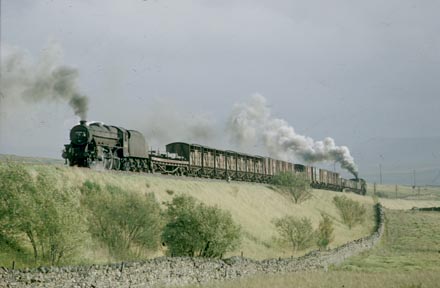
Ex LMSR class 5MT 4-6-0 number 45444 approaches Scout Green climbing to Shap summit with a down freight being banked by a BR Standard class 4 4-6-0
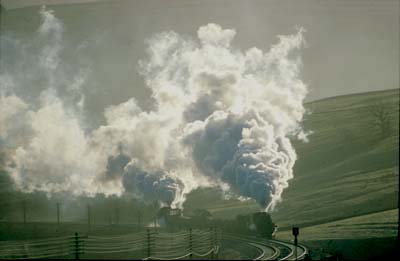
A BR Standard class 5MT 4-6-0 tackles the climb from Tebay to Shap summit and is seen approaching Greenholme banked by a Standard class 4 4-6-0 in December 1967

A BR Standard class 4 4-6-0 banks a down freight climbing to Shap summit headed by an ex LMSR class 5MT 4-6-0 that is approaching Greenholme
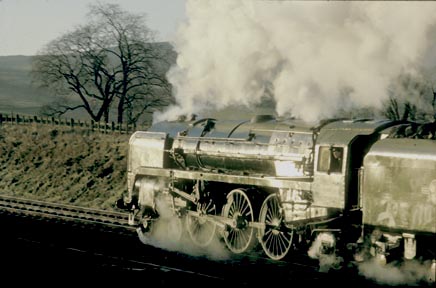
BR Standard class 7P6F 4-6-2 number 70045 'Lord Rowallan' approaches Shap summit with the Carlisle to Manchester Red Bank parcels in December 1967

Ex GWR 5100 class 2-6-2T number 4100 approaches Tramway Junction, departing Gloucester Central with the Cheltenham section of an express from Paddington
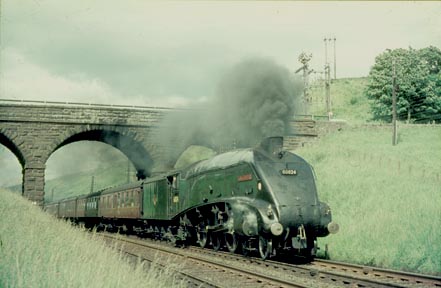
Ex LNER A4 class 4-6-2 number 60024 'Kingfisher' departs Gleneagles with an Aberdeen to Glasgow Buchanan Street express in August 1966
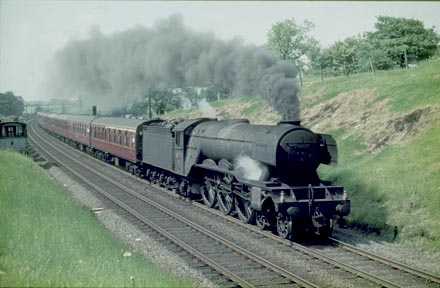
Ex LNER A3 class 4-6-2 number 60107 'Royal Lancer' approaches Stoke tunnel on an up express - 15/6/1963
1965 was a very eventful year in Scotland. I had three separate weeks' holiday concentrating on the Glasgow-Aberdeen route. Daytime was spent taking photographs, usually finishing at Perth in time to catch the southbound West Coast 'postal' which continued to Stirling before the passenger Glasgow portion was split. The first night I travelled on this train, I got chatting to the Carstairs crew who adopted me as fireman as far as Stirling and then I continued to Glasgow where I picked up the ll pm to Aberdeen. This was a regular 'A4' turn and by 'kipping on the cushions' I arrived at 3 am in time to go down to the fish market for breakfast. These arrangements continued for most of that week and occasionally I would fire the 'A4' back to Aberdeen. One night, whilst 'noshing' an Angus steak 'buttie' in Perth refreshment rooms the fireman of the 8.25 pm 'postal' entered in a fuming temper and threw his gloves at me uttering obscenities about a 'Britannia' (although that wasn't what he called it!) that wouldn't steam. I took the hint and as it was 8 pm I had 25 minutes to sort it out. I first tried the pricker but the clinker was absolutely solid, so all I could do was to build up the fire very carefully, but at 8.25 pm only 160 pounds per square inch showed on the gauge. The driver opened the regulator fully, allowing No. 70041 Sir John Moore to slip violently (a last resort to break up the fire), but after firing steadily to Gleneagles there was still only l60 psi on the gauge. This remained constant to Stirling where the idle fireman talked me into carrying on to Carstairs. Here, he was relieved by the Carstairs crew who were equally happy to let me continue to Carlisle where we arrived at midnight with Riley completely knackered. However, after a wash and breakfast in the railwaymen's bothy I boarded the 2.25 am to Perth behind Britannia No. 70048 The Territorial Army 1908-1958. By Beattock I was back on the footplate back to Perth, where I took a well-earned couple of hours 'kip' in the three star 'ecs hotel'.
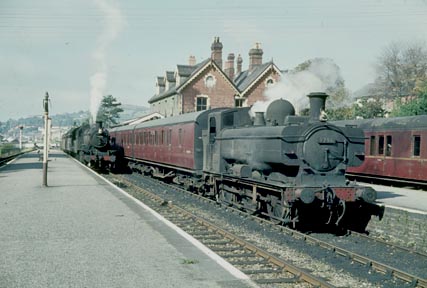
Ex GWR 5700 class 0-6-0PT number 9796 stands in Brecon station after arrival on a train from Neath with LMSR designed class 2 2-6-0 number 46511 standing in the other platform on a Mid-Wales line train - 6/10/1962
His reply was that he hadn't any cleaners on shed. To this, we said again that WE would clean it. Very mildly and half-heartedly he said that we couldn't do that. Not getting the inevitable marching orders we decided to hunt round for some cotton waste and paraffin. Working very fast we had the engine clean in no time but hit problems with the tender. A ladder was needed, so I slipped back into the gloom of the shed and laid my hands on one. Heading hack to the yard and No. 60027, I was spotted by the foreman. After all, I was a bit conspicuous with a damned great ladder over my shoulder. Carrying on, I sensed I was being followed, all the time fearing the big crunch and having to photograph a clean locomotive and dirty tender. By the time he had caught up with me, I had the ladder up on the tender and was going like mad with the cotton waste. To our amazement he stood watching with his hands behind his back and mouth wide open.
Eventually the silence broke: 'Ach, a've noo ever seen anything like it in 40 years of service!' He then insisted on being photographed with us and No. 60027! Even so, the final photograph at Glenfarg was a dead loss - but the cleaning session was very significant in being the first of a very long line of similar tasks. This procedure spread so rapidly and with such keen interest that crowds of us would leave our homes on Friday evenings to clean up anything from the Lymington branch engine to 'A4s' at Aberdeen Ferryhill (61B).

Ex LMSR class 8F 2-8-0 number 48448 climbs towards Copy Pit summit near Cliviger with a train of coal empties from Rose Grove on 24/2/1968
My request was that No. 60530 should be rostered to work the 10.15 am Dundee-Glasgow and the 6.15 pm return for one week commencing August 30. To this, BR agreed in part, namely to roster it for the Monday only. As Sundays were fairly quiet in Scotland, Dave Gouldthorp and I decided to spend the afternoon cleaning No. 60530 on Dundee MPD. Unfortunately, we hadn't allowed for the temperament of the shed foreman who just wouldn't hear of us cleaning one of HIS engines. Not to be outdone, we crept back at 2 am and spent three hours cleaning No. 60530 until you could have eaten your dinner off the top of the boiler. Next, it was off to Auchterarder for the outward journey and Dunblane for the return. As BR had informed me that it was for one day only, we took off for Ayrshire and the Fowler 'Crabs' on the Tuesday, only to find on our return to Glasgow that No. 60530 had worked the same turn again. Back to Dundee we went, to check the roster board for the Wednesday which read '10.15 am Glasgow - No. 44718.' During the wee hours this mysteriously became '10.15 am Glasgow - 60530.' As luck would have it, we just happened to be at Hilton Junction to photograph the outward journey and St. Rollox for the return. Although Monday evening's shot was useless, the other three were quite acceptable - all this in just three days after three years of trying.
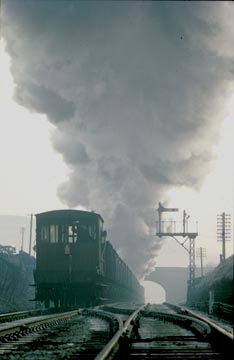
Left : The brakevan on an eastbound train
of coal empties breasting Copy Pit summit behind class 8F 2-8-0 number 48247.
Right : 8F 2-8-0 number 48448 climbs towards Copy Pit summit at
Portsmouth with a westbound train of coal - both on 24/2/1968

After only a couple of months the old Vauxhall began to break up - literally. The Buxton - Glossop road claimed the front bumper and the back one disappeared while chasing a special on the Southern near Andover. The last trip with the Vauxhall was certainly the most interesting. With the usual complement of five in the car, we chased a Stanier Class 5 up Shap from Tebay and when cornering fairly hard it started to handle very strangely. Upon investigation (naturally, after the shot) we discovered that a 2 ft length of leaf spring had come through the boot. The following day we continued to Berwick to see 'A4' No. 4498 Sir Nigel Gresley and on checking the oil and water levels I noticed that the engine had developed a ten degree list to one side (due to shattered engine mountings). This really put the wind up me' to the extent of imposing a 30 mph speed limit for the rest of the trip for fear of having a 1500 cc engine on our laps. Having taken the return shot of No, 4498 on Cockburnspath, we commenced the return journey from Grantshouse to Coventry. Thirteen hours of solid driving later, with stops only for black coffee, it was straight into work - and they call this enjoyment.
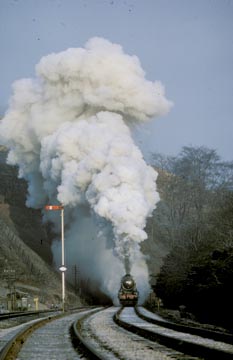
Left : 8F 2-8-0 number 48448 climbs from Holme tunnel
towards Copy Pit summit with a train of empties on 24/2/1968
Right : J27 class
0-6-0 number 65894 approaches Silksworth colliery climbing from Ryhope with a
train of empties on 8/9/1967
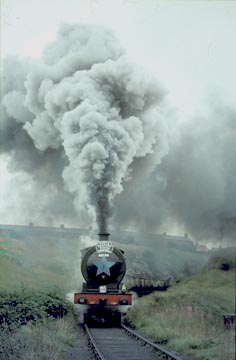

Ex LMSR class 2P 4-4-0 number 40646 stands in Bletchley station on an SLS Railtour on 14/4/1962
This was up a l in 10 out of the town. but I managed to pass everything that was stuck, including a milk float with snow- chains. At the top of the hill, two lorries had collided and closed the road so we had to turn back and try another road out. This time we tried the direct road to Buxton (the A537) which is via the Cat and Fiddle, much renowned in this type of weather - but I'd never heard of it - then. I soon learned. The first few miles were relatively easy. but then we hit snow drifts up to 8 ft deep. I soon discovered the only way of continuing was to hit them at 30/40 mph, first knocking a hole in them and of course getting stuck before reversing about 200 yards and blasting through the gap. From here the rate of progress was very slow and strenuous. It must have been sheer lunacy, but we pushed on until it happened. I completely missed a Y junction and embedded the motor in 4 ft of snow. Reluctantly we turned round, and that in a good 30 minutes, and back to Macclesfield where we went via Hazel Grove and down the A6 to Buxton - nine hours after leaving Coventry. Completely shattered, we went to the MPD to find out what '8Fs' were working - and what do you think the shed foreman said? \"You don't think we're going to send them out in this weather, do you?\" After that, there was only one place to go and that was the local alehouse before the return journey to Coventry which was a little easier and involved no shovelling.
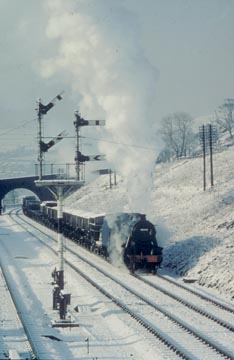
Ex LMSR class 8F 2-8-0 number 48442 approaches Chinley station with a Gowhole yard to Buxton freight on 3/2/1968

Ex LNER J27 class 0-6-0 numbers 65855, 65811, 65882, & 65879 gathered around the turntable in the roundhouse at Sunderland shed at the end of the last week of steam working in this area

